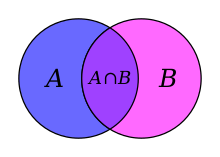Element (mathematics)
In mathematics, an element, or member, of a set is any one of the distinct objects that make up that set.
Sets
Writing means that the elements of the set A are the numbers 1, 2, 3 and 4. Sets of elements of A, for example , are subsets of A.
Sets can themselves be elements. For example, consider the set . The elements of B are not 1, 2, 3, and 4. Rather, there are only three elements of B, namely the numbers 1 and 2, and the set .
The elements of a set can be anything. For example, , is the set whose elements are the colors red, green and blue.
Notation and terminology
The relation "is an element of", also called set membership, is denoted by the symbol "∈". Writing
means that "x is an element of A". Equivalent expressions are "x is a member of A", "x belongs to A", "x is in A" and "x lies in A". The expressions "A includes x" and "A contains x" are also used to mean set membership, however some authors use them to mean instead "x is a subset of A".[1] Logician George Boolos strongly urged that "contains" be used for membership only and "includes" for the subset relation only.[2]
For the relation ∈ , the converse relation ∈T may be written
- meaning "A contains x".
The negation of set membership is denoted by the symbol "∉". Writing
- means that "x is not an element of A".
The symbol ∈ was first used by Giuseppe Peano 1889 in his work Arithmetices principia, nova methodo exposita.[3] Here he wrote on page X:
Signum ∈ significat est. Ita a ∈ b legitur a est quoddam b; …
which means
The symbol ∈ means is. So a ∈ b is read as a is a b; …
The symbol itself is a stylized lowercase Greek letter epsilon ("ϵ"), the first letter of the word ἐστί, which means "is".[3]
| Character | ∈ | ∉ | ∋ | ∌ | ||||
|---|---|---|---|---|---|---|---|---|
| Unicode name | ELEMENT OF | NOT AN ELEMENT OF | CONTAINS AS MEMBER | DOES NOT CONTAIN AS MEMBER | ||||
| Encodings | decimal | hex | decimal | hex | decimal | hex | decimal | hex |
| Unicode | 8712 | U+2208 | 8713 | U+2209 | 8715 | U+220B | 8716 | U+220C |
| UTF-8 | 226 136 136 | E2 88 88 | 226 136 137 | E2 88 89 | 226 136 139 | E2 88 8B | 226 136 140 | E2 88 8C |
| Numeric character reference | ∈ | ∈ | ∉ | ∉ | ∋ | ∋ | ∌ | ∌ |
| Named character reference | ∈ | ∉ | ∋ | |||||
| LaTeX | \in | \notin | \ni | \not\ni or \notni | ||||
| Wolfram Mathematica | \[Element] | \[NotElement] | \[ReverseElement] | \[NotReverseElement] | ||||
Cardinality of sets
The number of elements in a particular set is a property known as cardinality; informally, this is the size of a set. In the above examples the cardinality of the set A is 4, while the cardinality of either of the sets B and C is 3. An infinite set is a set with an infinite number of elements, while a finite set is a set with a finite number of elements. The above examples are examples of finite sets. An example of an infinite set is the set of positive integers, {1, 2, 3, 4, ...}.
Examples
Using the sets defined above, namely A = {1, 2, 3, 4 }, B = {1, 2, {3, 4}} and C = {red, green, blue}:
- 2 ∈ A
- 5 ∉ A
- {3,4} ∈ B
- 3 ∉ B
- 4 ∉ B
- Yellow ∉ C
References
- Eric Schechter (1997). Handbook of Analysis and Its Foundations. Academic Press. ISBN 0-12-622760-8. p. 12
- George Boolos (February 4, 1992). 24.243 Classical Set Theory (lecture) (Speech). Massachusetts Institute of Technology.
- Kennedy, H. C. (July 1973). "What Russell learned from Peano". Notre Dame Journal of Formal Logic. Duke University Press. 14 (3): 367–372. doi:10.1305/ndjfl/1093891001. MR 0319684.
Further reading
- Halmos, Paul R. (1974) [1960], Naive Set Theory, Undergraduate Texts in Mathematics (Hardcover ed.), NY: Springer-Verlag, ISBN 0-387-90092-6 - "Naive" means that it is not fully axiomatized, not that it is silly or easy (Halmos's treatment is neither).
- Jech, Thomas (2002), "Set Theory", Stanford Encyclopedia of Philosophy
- Suppes, Patrick (1972) [1960], Axiomatic Set Theory, NY: Dover Publications, Inc., ISBN 0-486-61630-4 - Both the notion of set (a collection of members), membership or element-hood, the axiom of extension, the axiom of separation, and the union axiom (Suppes calls it the sum axiom) are needed for a more thorough understanding of "set element".
